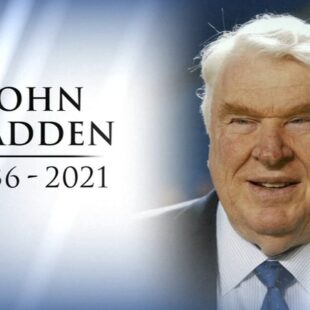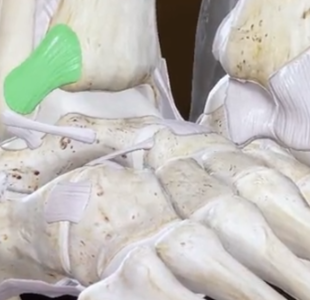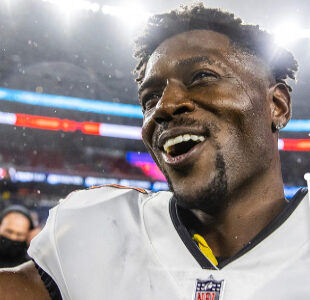For the last few years, the NFL has been under fire to make the sport of American Football safer. We are inundated with reports about chronic traumatic encephalopathy, or CTE, which comes from repeated blows to the head. In the GFL series I address the impact multiple concussions can have on a player’s health. If I was to continue the series until Quentin Barnes was in his 40s, you can bet he would be suffering the effects of CTE. You can see an image of a normal brain compared to one with advanced CTE below-right.
 The increased awareness of long-term damage has led to some players retiring early out of concern for their long-term health. Hell, the subject has become so hot that even one EPSN analyst walked away from his job. As a former sports reporter myself, I can tell you there are many know-nothing grandstanders in that profession, people who have always cheered for the big hits and the big hitters. When even the media is saying enough is enough, you know that message is getting some traction.
The increased awareness of long-term damage has led to some players retiring early out of concern for their long-term health. Hell, the subject has become so hot that even one EPSN analyst walked away from his job. As a former sports reporter myself, I can tell you there are many know-nothing grandstanders in that profession, people who have always cheered for the big hits and the big hitters. When even the media is saying enough is enough, you know that message is getting some traction.
So, what is the NFL doing about it? For the 2017 season, here are some key rule changes meant to improve player safety:
TOUCHBACKS MOVED TO THE 25-YARD-LINE INSTEAD OF THE 20-YARD-LINE
This rule was introduced in 2016, and has been extended to 2017.
A “touchback” is when Team A kicks off the ball, and it either goes out of the back of the end zone or the receiving player “downs” it in the end zone (meaning he takes a knee, which instantly ends the play). The goal of this rule is to reduce what the NFL calls “the most dangerous play in football” — the kick return. Big bodies have time to accelerate to full speed, from both directions, then smash into each other in an eye-twitching display of physics.
Some analysts (such as in the video, below) thought this new rule might backfire, as some coaches would rather kick the ball to the 5-yard-line or so, keeping it out of the end zone, forcing the returning team to return the kick (the kickoff is a live ball recoverable by the kicking team until the receiving team takes the touchback, “downs” themselves by falling on the ball, or the kick returner is tackled). Forcing them to return the kick might result in the ball not making it to the 25-yard-line or beyond, resulting in a net positive in field position for the kicking team (in football, field position is a huge factor, and every yard counts).
However, the end result of the 2016 rule change was a 1.8% reduction in kicks returned. The NFL wants another year to gather data to see if this will become a permanent rule change.
RECEIVERS RUNNING A PASS ROUTE NOW HAVE DEFENSELESS PLAYER PROTECTION
A “defenseless player” is a relatively new concept — check out this wonderful NFL video defining a defenseless player. If someone is trying to catch a pass, focusing their attention on the ball, they are “defenseless” against a defensive player who is trying to time the play so he can deliver a major hit just as the receiver catches the ball. Having played in high school, I can vouch that the best hits come when someone doesn’t see you coming. For guys the size of NFL players, such hits are hard to watch. Sure, I used to cheer at those hits, I used to root them on, but now they sicken me.
So with this new rule, someone running a pass route is given the same protection. A “pass route” is the route a receiver runs to get to a particular area of the field, where the quarterback has the option of throwing to him. The purpose of a pass route is mostly timing, to make sure the quarterback knows exactly where the receiver is going so the quarterback can properly time his throw. It a defensive player tees off on a receiver in the process of running a pass route, or even after an interception, that is now a penalty. The penalties are on the field, but can also result in fines or suspensions at the discretion of the NFL.
CRACKBACK BLOCK TARGET RECEIVES DEFENSELESS PLAYER PROTECTION
Well, it’s about time someone started looking out for the defensive side of the ball! A “crackback” block is when someone from far outside the play moves out of the defensive player’s line of sight, then, as the play swings toward him, that blocker is able to lay a blindside hit on the defender, whose attention is focused on the ball. An excellent definition is at 1:32 of this video (which is the same video linked above).
THE FULL LIST OF CHANGES REGARDING PLAYER SAFETY
Here’s the full list of changes for the 2017 season. Is the NFL serious about changing the game to protect players, or are the powers that be just trying to protect themselves from further lawsuits? Maybe both. The quality of the product on the field depends on keeping the best players on the field. The league has know this for years and has tried to make changes accordingly, even before the CTE controversy. If Aaron Rogers puts butts in the seats and eyes on TV broadcasts full of lucrative commercials, you want to make sure Rogers stays on the field.
I think many more changes need to be made. “Big hits” use to be a hallmark of the league, but they damage players — and players are first and foremost human beings — and need to be reduced or even eliminated. Football is and always will be a violent sport, but everything that can be done to improve player health and longevity should be done, for the sake of common sense and for the bottom line.

































